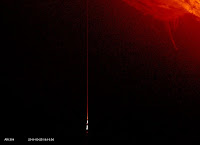
One of SDO’s main science goals is to study how the changes in the Sun (solar cycle, flares, etc.) drive changes here at the Earth, a subject called “Space Weather”. Guess what? These solar events also drive similar changes in the atmosphere of Mars!
There is a mission to Mars called the Mars Atmosphere and Volatile Evolution Mission (MAVEN) that is currently being built and is set to launch to Mars in late 2013. One of MAVEN’s instruments is an EUV monitor, which is a very simple version of the SDO EVE instrument, and it will measure the solar irradiance output and its variations at Mars. Other complementary instruments will also be looking to see how much these solar variations directly influence the Martian atmosphere.
One major goal of the MAVEN mission is to determine how much the solar variations affect the temperatures, densities, composition and the rate of loss of the Martian atmosphere today. These measurements will then be used to determine how dense and what the composition of the atmosphere of Mars may have been in the past!
The lead institution for MAVEN is the University of Colorado’s Laboratory for Atmospheric and Space Physics (where SDO/EVE was built!) and the MAVEN PI is Bruce Jakosky. NASA Goddard Space Flight Center, where SDO was built and managed, is also managing the MAVEN mission.
You can find out more on the MAVEN mission at:
Website: http://lasp.colorado.edu/maven/
Twitter: MAVEN2MARS



